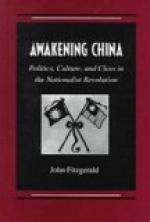Patachu, in the adjacent hills, used to be a favourite [Page 35] summer resort for the legations and other foreigners before the seaside became accessible by rail. Its name, signifying the “eight great places,” denotes that number of Buddhist temples, built one above another in a winding gorge on the hillside. In the highest, called Pearl Grotto, 1,200 feet above the sea, I have found repose for many a summer. I am there now (June, 1906), and there I expect to write the closing chapters of this work. These temples are at my feet; the great city is in full view. To that shrine the emperors sometimes made excursions to obtain a distant prospect of the world. One of them, Kien Lung, somewhat noted as a poet, has left, inscribed on a rock, a few lines commemorative of his visit:
“Why have I scaled this dizzy height?
Why sought this mountain den?
I tread as on enchanted ground,
Unlike the abode of men.
“Beneath my feet my realm I see
As in a map unrolled,
Above my head a canopy
Adorned with clouds of gold.”
The capital consists of two parts: the Tartar city, a square of four miles; and the Chinese city, measuring five miles by three. They are separated by imposing walls with lofty towers, the outer wall being twenty-one miles in circuit. At present the subject people are permitted to mingle freely with their conquerors; but most of the business is done in the Chinese city. Resembling other Chinese towns in its unsavoury condition, this section contains two imperial temples of great sanctity. One of these, the Temple of Heaven, [Page 36] has a circular altar of fine white marble with an azure dome in its centre in imitation of the celestial vault. Here the Emperor announces his accession, prays for rain, and offers an ox as a burnt sacrifice at the winter solstice—addressing himself to Shang-ti, the supreme ruler, “by whom kings reign and princes decree justice.”
The Temple of Agriculture, which stands at a short distance from that just mentioned, was erected in honour of the first man who cultivated the earth. In Chinese, he has no name, his title, Shin-nung signifying the “divine husbandman”—a masculine Ceres. Might we not call the place the Temple of Cain? There the Emperor does honour to husbandry by ploughing a few furrows at the vernal equinox. His example no doubt tends to encourage and comfort his toiling subjects.
Another temple associated with these is that of Mother Earth, the personified consort of Heaven; but it is not in this locality. The eternal fitness of things requires that it should be outside of the walls and on the north. It has a square altar, because the earth is supposed to have “four corners.” “Heaven is round and Earth square,” is the first line of a school reader for boys. The Tartar city is laid out with perfect regularity, and its streets and alleys are all of convenient width.




